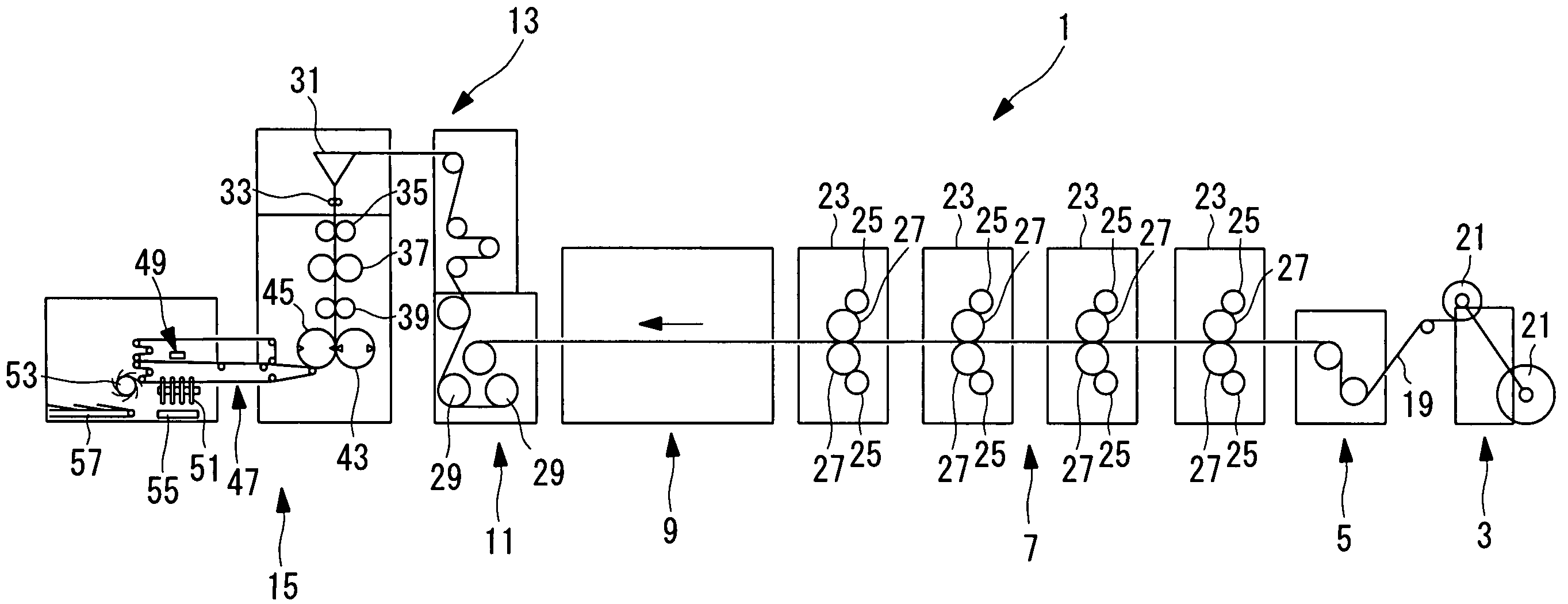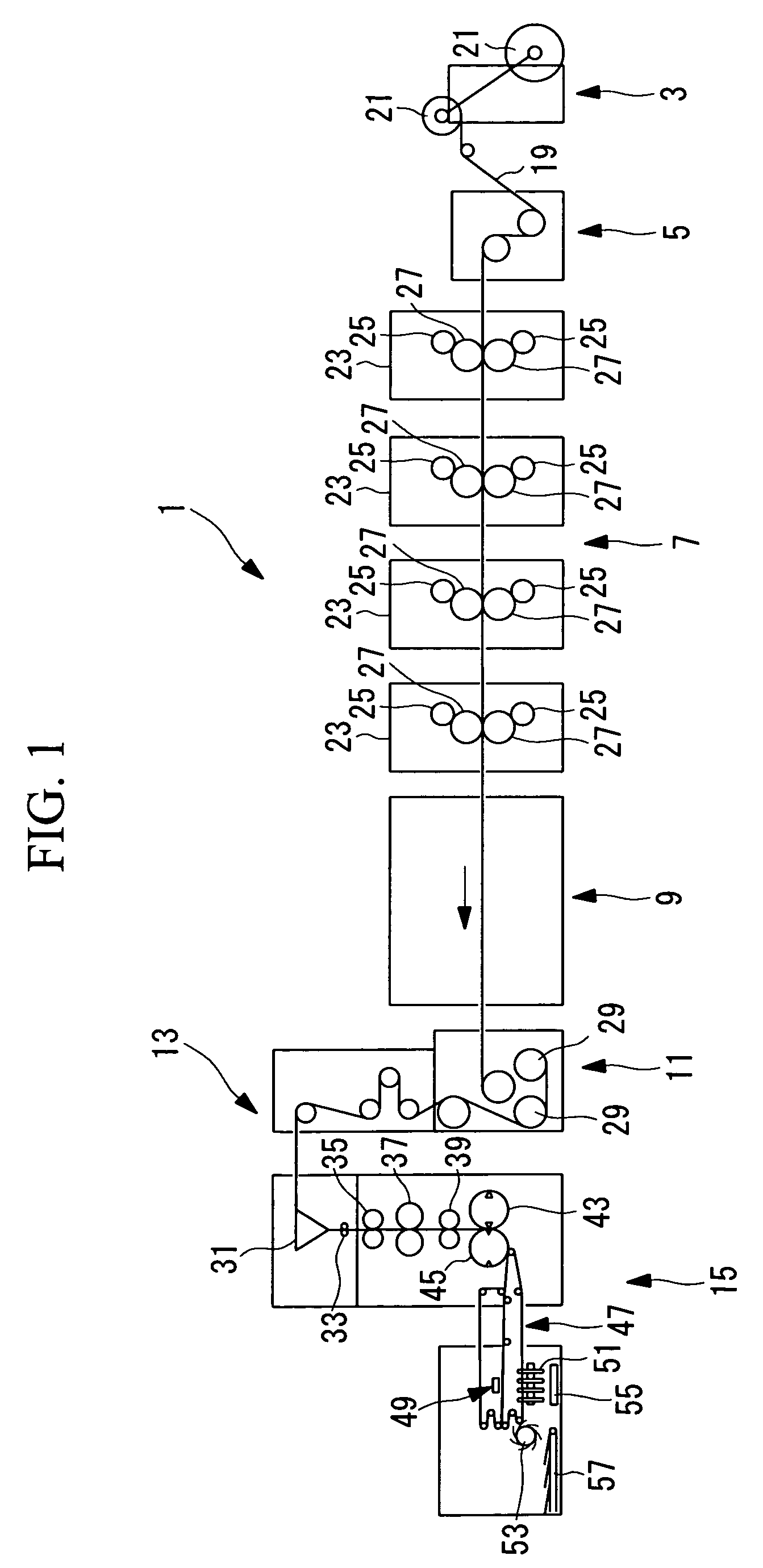Folding machine and printing machine using same
a printing machine and folding machine technology, applied in the field of folding machines and printing machines, can solve the problems of inability to smoothly move the signature at both ends, and inability to accurately fold the signature, etc., to achieve good products, improve folding accuracy, and simple structure
- Summary
- Abstract
- Description
- Claims
- Application Information
AI Technical Summary
Benefits of technology
Problems solved by technology
Method used
Image
Examples
first embodiment
[0065]A first embodiment of the present invention is described with reference to FIGS. 1 to 6.
[0066]In the first embodiment, the present invention is applied to an opposed blanket type web press that perform multicolor printing on both sides of a web.
[0067]FIG. 1 is a front elevation view illustrating a schematic structure of an entire web press (printing machine) 1.
[0068]The web press 1 includes, along a conveyance direction of a web 19, a paper feed device 3, an in-feed device 5, a printing section 7, a drying device 9, a cooling device 11, a web pass section 13, and a folding machine 15.
[0069]The paper feed device 3 supplies a web 19, and holds two paper rolls 21 that are formed of rolled webs 19.
[0070]While the paper is supplied from one paper roll 21, the other paper roll 21 is installed to prepare for paper splicing. When the web 19 of the one paper roll 21 comes to an end, the web 19 is spliced to the web 19 of the other paper roll 21. While the web 19 is supplied from the ot...
example
[0173]A printing was performed using the POLYBELT® Type KCS-350 (width: 15 mm, thickness: 1.1 mm) produced by Nitta Corporation having a configuration shown in FIG. 4 for the lower conveyance belt 65 and the upper conveyance belt 75 in the printing device LITHOPIA MAX AY1-700 produced by Mitsubishi Heavy Industries, Ltd., and 16 pages of A-4 sized chopper signatures 60 were obtained.
[0174]A coefficient of static friction of the lower conveyance surface 103 and the upper conveyance surface 105 to a surface formed of an iron material was set to 0.2 or more and less than 0.3.
[0175]For the web 19, two types of coated paper of basis weight of 49 g / m2 and 73 g / m2 were used. A printing speed, that is, the number of rotations of the plate 25 was varied to 600, 650, 700, 750, and 800 rpm. Under the conditions, signatures 59 were examined for any rip formed due to contact with the stopper 87 (such a rip hereinafter referred to as a “contact rip”).
second embodiment
[0184]Now, the web press 1 according to a second embodiment is described with reference to FIG. 8.
[0185]The second embodiment differs from the first embodiment only in structures of the holding force increasing sections. Accordingly, in the second embodiment, the different point is mainly described, and the descriptions of the same parts as the above-described first embodiment are omitted.
[0186]To the same members as those in the first embodiment, the same reference numbers are applied.
[0187]In the second embodiment, the bent section (plate-like member) W in the upstream side of the chopper table 85 is provided in the upstream side, for example, the bent section W is extended to a point near the upper guide roller 81 of the upstream side.
[0188]The bent section W may have a predetermined curvature, or, gradually varying curvatures.
[0189]Unlike the first embodiment, the nip roller 71 is not used, but the convex section T that protrudes upward is formed on the lower conveyance path sec...
PUM
| Property | Measurement | Unit |
|---|---|---|
| friction coefficient | aaaaa | aaaaa |
| thickness | aaaaa | aaaaa |
| thickness | aaaaa | aaaaa |
Abstract
Description
Claims
Application Information
 Login to View More
Login to View More - R&D
- Intellectual Property
- Life Sciences
- Materials
- Tech Scout
- Unparalleled Data Quality
- Higher Quality Content
- 60% Fewer Hallucinations
Browse by: Latest US Patents, China's latest patents, Technical Efficacy Thesaurus, Application Domain, Technology Topic, Popular Technical Reports.
© 2025 PatSnap. All rights reserved.Legal|Privacy policy|Modern Slavery Act Transparency Statement|Sitemap|About US| Contact US: help@patsnap.com



